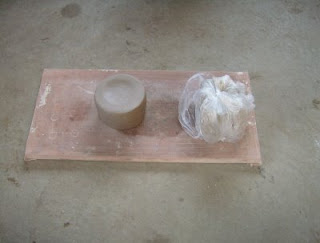
This birdfeeder has been sitting on our deck for the past six years and over that time I never gave it much thought. It was almost like it wasn't even there. Quite often it didn't even have bird seed in it (sorry birds). Yesterday I happened to take a closer look at it and thought to myself "Hey Man! This is really a cool birdfeeder." Anyway, on to the story behind the feeder.
When I got back into clay, after a 10-year hiatus, this is the first thing I made. I still had all my clay tools but had no clay, glazes or underglazes, so I got on the phone and ordered some materials to get me back into clay. Kind of odd because although I ordered the stuff to start making things, I had no way of firing them. I didn't even think of that. I must have been caught up in the excitment of getting muddy again.
Ok. The stuff was ordered and it would take a week to deliver. In that time I was constantly wondering what I was going to make. Not only did I not have a kiln, I also did not have a potter's wheel so I was going to be limited to handbuilding whatever project I decided to tackle. I sat on the deck trying to sketch out some ideas in my sketch book and realized we didn't have a birdfeeder to feed any of the birds chirpping about the deck rails--Tah-Dah! A Birdfeeder was going to be the first project.
Still at the sketchbook, nothing seemed to be working for me and eventually I ended up looking at drawings of a pitched roof with four supporting columns. Thank goodness the clay gods stepped in and I had an epiphany--The Parthenon of Ancient Greece! Unfortuantely, after looking at a photo of the temple, it seemed to be too big of an unertaking for me so I started looking at other photos of Greek Temples. Turned out that all of the temples seemed to intimdate the hell out of me so I looked at my last drawing, the one with four columns and a pitched roof, and said I'll just make this simple but "Greek-like." And, it worked.
Once I had created my temple I still had no way to fire it. A couple months later I ended up enrolling in a pottery class at the college, fired the feeder and a bunch of other projects, and the rest is ancient history.
The birdfeeder is made out of a lowfire talc clay body and I used a red iron wash for the roof and and used a more diluted soultion for the base. I then brushed three coats of lowfire clear glaze on everything but the top part of the roof. It has been outside in the elements ever since and gets better looking with time. If you click on the photo to enlarge it you can see that lichen has started to grow on the feeder making it look even more "ancient." Well, thats the story. Hope I didn't bore you, but I really thought the whole thing was worth documenting.
Cheers!












